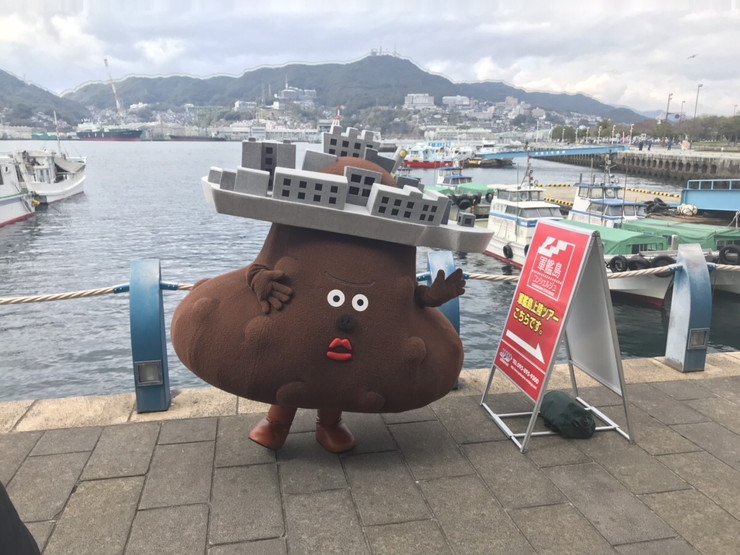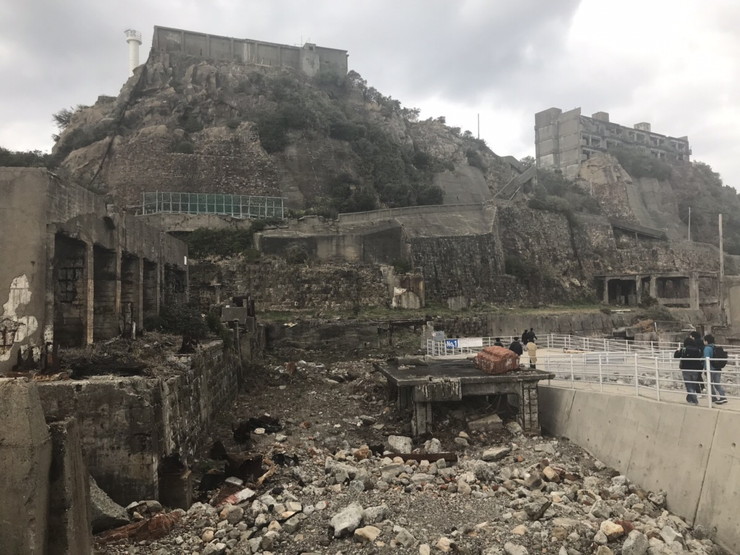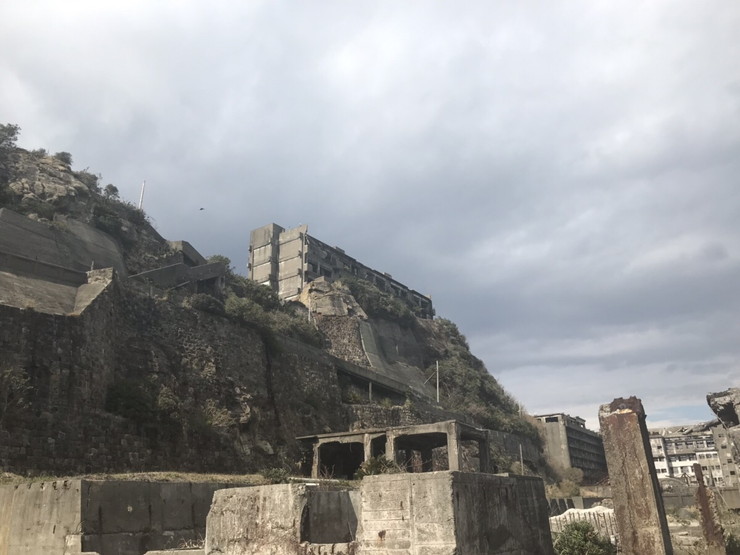This time, in creating this website, we have been kindly allowed to participate in a landing tour organized by the Gunkanjima Concierge, which has provided information and assisted in data gathering.
Here, we present a report on a tour we actually participated in, along with the charms of Gunkanjima!
Assistance in data gathering
The Gunkanjima Concierge
The Gunkanjima Concierge

*Landing results of 2011 to 2018
This time, we present the Gunkanjima Concierge, which kindly allowed us to participate in a Gunkanjima landing tour. Its major feature is that the average landing rate is as high as 94.7 %(*)!
By actually being kindly allowed to participate in the tour, we were able to feel the hospitality of the guides and the staff. If you are considering a Gunkanjima tour, by all means check it out.

Going to the Tokiwa Pier, a departure and return point for participation in Gunkanjima tours
Immediately upon arrival, we were given landing passes by the staff.

Landing tours run by the Gunkanjima Concierge have two trips, one in the morning and one in the afternoon. This time, we participated in the afternoon trip. It leaves port at 13:40 (1:40 pm).
As we waited for the embarkation, the group of people around grew a little lively. I thought, “What is the matter?” and look at the person who spoke…

It was Gansho-kun!
*Gansho-kun from Gunkanjima
It is a character who has made Gunkanjima his motif and seems very popular in Nagasaki.
Since I had done plenty of research beforehand, I was able to meet the person face to face and was quite impressed!
As expected, he was a popular person and was surrounded by the participants in the tour, who wanted to take commemorative pictures with him.
Meanwhile, a cruise ship arrived at the wharf.
Click here to board this time!

Its name is Jupiter (in the distance). It is a cruiser that can accommodate 200 people!
As I heard from the staff, there was little pitching and rolling due to a special design, and measures were taken to prevent seasickness.
It was good news for me, who was prone to seasickness (although I had taken a motion sickness pill beforehand)!
However, in the afternoon, the waves were getting higher and the pitching and rolling were getting stronger. I still felt a little uneasy.
Another worry was whether we would be able to land.
If the waves are too high, there are cases where, although the boat can get close to Gunkanjima, the landing is impossible.
However, this was the Gunkanjima Concierge with a landing rate of 94.7% (*). So I expected to be able to land, unless something extraordinary were to happen!
*Landing results from 2011 to 2018

The participants boarded the boat one after another.
That day was a weekday, so about 130 people participated in the tour. It is said to be almost full on weekends, and I was surprised again at the popularity of Gunkanjima tours.
Then, Gansho-kun came to see us off.


He saw us off just before everyone boarded. He was brave and cute.
Then it was time for me to board. This time I was given a seat on the second deck (with the best view!). Thank you for a very nice seat!

It was time to leave port.
The details of a Gunkanjima tour (an afternoon trip) are like this!
It is a cruise of about two and a half hours.
In fact, there is plenty to see on the way to Gunkanjima.
Along with Gunkanjima, the Sites of Japan’s Meiji Industrial Revolution have also been registered as World Heritage.
The ability to see such things is also a real pleasure of the tour.
From here on, I will report while presenting the World Heritage Sites located on the way to near Gunkanjima.

Immediately, the first World Heritage Site, the Giant Cantilever Crane, went to the right! Although it moved far away, it is the green crane on the right edge of the picture.
Click here for images that are easy to understand.

It is the first large cantilever crane in Japan, built in 1909. Believe it or not, it is still in operation, although more than 100 years have passed!
After passing the Giant Cantilever Crane, you will see the Mitsubishi Nagasaki Shipyard.

The white building on the right is the main building of the Nagasaki Shipyard, and in front of it is the Third Dock (its mark is the dark green area with the words “No. 3 DOCK”).
As you look at the Sites of Japan’s Meiji Industrial Revolution, the tour boat will finally head for the open sea.

The Megami Ohashi Bridge is right on its border. The pitching and rolling of the boat became a little greater after it passed under the bridge.
After a short trip from the Megami Ohashi Bridge, the boat arrives at Iojima. It is also a departure and return site for Gunkanjima tours, and several participants board here.

A short while after we left Iojima, we saw a big island on the right.
It was the Takashima Coalmine (Takashima), which, just like Gunkanjima (Hashima), supported the industrial revolution in Japan, and had been registered as a site of Japan’s Meiji Industrial Revolution.

As you pass Takashima, you will see Nakanoshima. Coalmining was carried out there as on Hashima and Takashima, but it did not last long.
And did you notice that picture?
Yes, what you see behind Nakanoshima is Gunkanjima. We are finally there!

Well, now I am face to face with the long-awaited Gunkanjima. It is a bit far off, but it definitely looks like a battleship.
Its appearance is conspicuous, completely different from Takashima and Nakanoshima, which I saw on the way. It allows me to perceive the unique history and culture of Gunkanjima.
At that moment, I was called by the staff and guided to the front deck!
What a special time I was given to have a view of the whole of Gunkanjima up close. Thank you very much!
*Guidance to the front deck is a benefit of premium tickets.

The sea was rough and the waves and wind were high, and the boat pitched and rolled violently, but the scenery was so wonderful that it did not matter at all. It is frustrating that the picture cannot convey everything, but I felt the majesty emanating from Gunkanjima with all my body.
Boosted by the weather of the day, Gunkanjima was floating in the cloudy sky and the sea spray. Enchanted by the atmosphere of inaccessibility and the peerless presence, I stood still for a while.
As the boat went around, Gunkanjima presented itself from various angles.
After cruising around Gunkanjima for ten minutes or so, we finally made a landing.

At 14:40 (2:40 pm), we arrived on Gunkanjima, almost on schedule.
The boat arrived at the Dolphin Pier, the only landing point.
I was excited with the expectation of landing

It was my memorable first landing!
On the way from the Dolphin Pier to the island, I was painfully aware of some areas that had been damaged by Typhoon No. 25 last October (2018) and had had to be repaired.




Proceeding along the path to the island, I headed for the first observation area.

After landing, you can go on a tour while listening to the guide’s explanation in three observation areas.

From the first observation area, you can see Building No. 3 and the water storage tank to the north, and the Hashima Elementary and Junior High School and Building No. 65 to the northeast.
As everyone had arrived, the guide Ms. Uchida began her explanation.

This building, which can be seen on the hill, is the water storage tank that supported the life of the islanders.
It seems the most difficult thing in life on Gunkanjima was to secure water.
In the early days, water must have been stored in this water tank and used, but with the increase in population and development, a submarine water pipeline was laid under the seabed.
It was the first submarine water pipeline in Japan, and I was greatly surprised that it was drawn from the Nagasaki Peninsula.

Next, Building No. 3 is located the right of the water tank. This is reportedly the dormitory where the Mitsubishi executives lived.
The people who worked on Gunkanjima were paid higher wages than ordinary workers at the time, but those who lived in this Building No. 3 seem to have been paid nearly twice the amount!
At that time, the salary of a bank clerk in Nagasaki was about ¥70,000 a month. It seems that the coalminers on Gunkanjima were paid ¥150,000, more than twice the amount, and the executives were paid nearly ¥300,000 a month.
In current money, the coalminers were paid ¥500,000 to ¥700,000 a month, and the executives, ¥1,000,000 to ¥1,300,000 a month…!
That also means that the job was extremely difficult.

Looking to the right of the Building No. 3 and far away, you can see a bigger building. This is the Hashima Elementary and Junior High School, which was the only school on Gunkanjima.
The first to fourth floors were occupied by the elementary school, and the fifth to seventh, by the junior high school.
By the way, there was no high school on Gunkanjima, and children went to high school on neighboring Takashima.

Here comes a shocking fact from the guide Ms. Uchida!
“A few years ago, as I was working as a guide just like today, there was a loud crash. When I looked in the direction the sound came from, I saw that the roof of the Hashima Elementary School had collapsed.
“It was a moment that I saw decay and collapse in progress, unfolding right before my eyes.”」

To be sure, part of the roof has collapsed.
I felt the joy of seeing Gunkanjima now again, thinking that the island built up with edifices that were more than 100 years old would not be in that state forever.

The building, part of which is visible to the left of the Hashima Elementary School, is Building No. 65 (the Patriotic Dormitory). It is the largest building on Gunkanjima and it is a large-scale residence with more than 300 units in total.
Alongside Building No. 30, it is a very important building in Japanese architectural history, but because it is in a restricted area, you can only see it in this way from a distance.
The U-shaped building is nine stories high and it had a kindergarten on the roof.
Since there was no elevator, the children climbed to the ninth floor every morning. It must have given them some strong legs!
I also heard from the staff members of the Gunkanjima Digital Museum who were former islanders that they had played baseball on the roof of that Building No. 65.
If they had dropped the ball, it surely would have been tough.
Thinking of it, there is an anecdote that, because of that, their muscular control had improved and they had become a powerful team to win a tournament…! (Laughs)


I have heard a valuable story from the guide Ms. Uchida and now I will move on to the second observation area.
In the second observation area, you can see the Mitsubishi general office and the ruins of the pier at the mouth of the second shaft.


These ruins of the pier at the mouth of the second shaft are the entrance to the mine deep underground that was the place of work for the miners.
They were dropped to a depth of 600 m at a speed of 8 m/s. The miners worked eight-hour shifts in a harsh environment inside the mine at a temperature of 47°C and a humidity of 90 to 100%.
There were also many people who could not go down the stairs on their own, meaning that they must have realized the preciousness of life every time they came back.

The guide Ms. Uchida also said that,
“We owe our standard of living to all the miners who supported the industrial revolution, including those on Gunkanjima.
“I work as a guide and consider it to be a good opportunity to tell as many visitors as possible that there were such people, and to thank those who died.”
Her words conveyed deep sentiment.

Next, I headed for the third observation area along the dike erected on the southwest side.
Here, from close quarters, I could view a valuable building that has left a lasting mark in the history of Japanese architecture, a building representative of Gunkanjima.

Building No. 30 is the oldest reinforced-concrete apartment building in Japan. More than 100 years have passed since it was erected, and it has certainly decayed, but it remains standing in that place.
However, as with the other buildings, the facts of the matter are that it is not surprising that it may collapse at any time.
84 years from the beginning of full-scale mining (1890) to the closure of the mine (1974)
45 years from the closure of the mine (1974) to the present (2019)
How do things made by people change when people abandon them? I felt that it was an interesting point of view in the history of Gunkanjima that will continue into the future.

The visit of Gunkanjima was limited to part of the southern side. Although the landing lasted about an hour, it was a fulfilling tour that was replete with many highlights and interesting stories.
Above all, I felt that it was an extremely valuable experience to be able to actually land and feel the air of this place that has supported the history of Japan.
The history of Gunkanjima will unfold into the future, too. A future of collapse may lie in store there, but more than that, there is a mission to present the history and culture created on this island to future generations.
I hope this site can also play a part in it.
In addition, the Gunkanjima Concierge, which gladly undertook to assist in data gathering and provide information this time, also makes various attempts and engages in miscellaneous activities to pass down Japan’s industrial heritage, including Gunkanjima, to future generations.
The best example of this is the Gunkanjima Digital Museum. It is an innovative museum that has been set up using digital technology in order to acquaint the younger generation with the history of Gunkanjima and of the Japanese industry that should be passed down.
Another major feature is that you can learn about the current status of Gunkanjima, which is decaying and crumbling down. It is a museum that great things are expected of, and it may play the role of a World Heritage center in the future.
Assistance in data gathering
The Gunkanjima Digital Museum
The Gunkanjima Digital Museum

It is a new type of museum that uses the latest digital technology to convey the history and culture of Gunkanjima. It is a great attraction that lets you get a virtual experience of Gunkanjima, which is for the most part a restricted area, let alone learning about the facts and rumors of the lives of the islanders.
It is a digital museum that lets you know about Gunkanjima more than Gunkanjima itself. We recommend that you drop by when you go on a tour.
In many cases, it is impossible to land due to sea conditions and bad weather. However, with the cooperation of the Gunkanjima Concierge, which boasts a high landing rate of 94.7% (*), we present a report on the landing tour that we participated in. We will acquaint you with all the charms of Gunkanjima, not to mention the highlights of the tour!
※Landing results from 2011 to 2018
